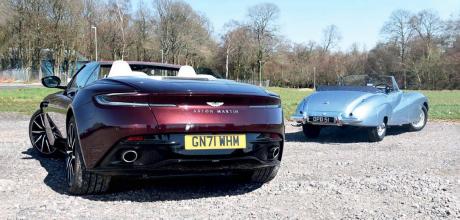75 years of Aston Martin’s DB sports cars - 1948 DB1 vs 2023 DB11
Although Aston Martin’s first post-war sports car from 1948 was officially called the 2-Litre Sports, it’s more commonly known as the DB1, the first of a long line of models to use the name that continues to this day. To mark 75 years of the DB range, we’re comparing the first and last to use it.
WORDS & PHOTOGRAPHY PAUL WALTON
HISTORY 75 YEARS OF DB — DB1 MEETS DB11
To mark 75 years of Aston Martin’s DB sports cars, we’re pairing the first from 1948, the DB1, together with the current DB11

Other than a pair of ‘Ms’, can any two letters sound as exciting when joined together than ‘D’ and ‘B’? Representing some of the fi nest performance cars ever made in this country, ‘DB’ has become as famous as the models themselves and one of the few car names that’s become part of our mainstream culture. This is partly due to its longevity. Although officially first used in 1950, an even older car can claim to be the first. To explain this history, we’re looking at the original model to be unofficially given the name, the 2-Litre Sports, plus its current descendent, the DB11 Volante.
When northern industrialist, David Brown, bought Aston Martin in 1947, what he got was a car company that wasn’t actually producing any cars. What it had, though, was an awkward-looking four-door saloon prototype that was put together between 1939 and 1940. Commissioned by AM’s then managing director, R. Gordon Sutherland – who christened it the Atom since it had lots of performance in a small package – the car was the work of the company’s lead engineer, Claude Hill.
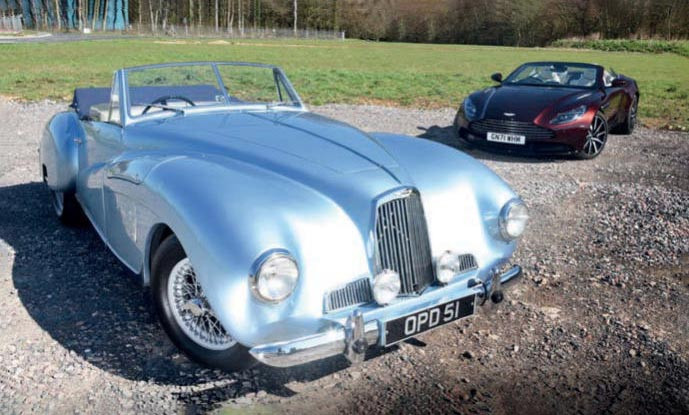
It was based on a modern tubular chassis that used square and rectangular section tubes, which Hill had first experimented with several years earlier for another prototype that was informally known as ‘Donald Duck’. The Atom was originally powered by Aston’s existing SOHC 2.0-litre inline four that was fitted to the Speed Model cars between 1936 and 1940, but was replaced in 1944 by a new engine, an OHV 2.0 that was again the work of Hill.
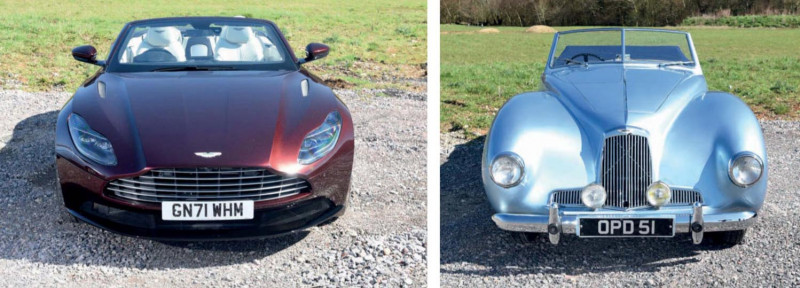
Brown only bought the company after test-driving the prototype and seeing its potential. “I decided to try the Atom and took it home, and put it through its paces over the Pennines,” reminisced Brown in Geoff Courtney’s 1978 book, The Power Behind Aston Martin. “I liked it, particularly the superb road holding although it was a bit underpowered and not very good looking.”
To solve the issue of the 2.0-litre’s lack of power, Brown later bought Lagonda for its new W.O. Bentley-designed 2.6-litre straight-six engine. But with this motor not due to be ready for some time, yet knowing Aston needed a new model, he commissioned Hill to update the Atom for production.

After Claude Hill and works test driver, St John (Jock) Horsfall, drove a bare chassis on the road for several weeks, it was decided the best way to evaluate the car was to race it. And so, the third prototype built was entered into the gruelling 1948 Spa 24 Hour Race in July and fitted with a narrow, vintage-looking body plus cycle wings and a tall radiator grille. The drivers were Horsfall plus Leslie Johnson who had enjoyed a decent level of success in rallies before the war.
In terrible weather conditions, the Delage D6 of the French pairing, Henri Louveau and Louis Gérard, quickly took the lead, but it was soon overtaken by the Italian, Luigi Chinetti, driving a Ferrari 166S. But following Gérard crashing the Delage because of heavy rain and the Ferrari’s head cracking at midnight, the Aston of Horsfall and Johnson eventually took the lead and stayed there for the victory.
It was an incredible result and clearly showed what the 2.0-litre prototype was capable of. “This convincing victory by this new British high-performance car puts Aston Martin right on the map again in a sphere of competition activity in which this make has always excelled,” said Motorsport magazine’s report of the race in its August 1948 issue. “How impatiently private sportsmen will now await delivery of the latest 2-litre Aston Martin!”
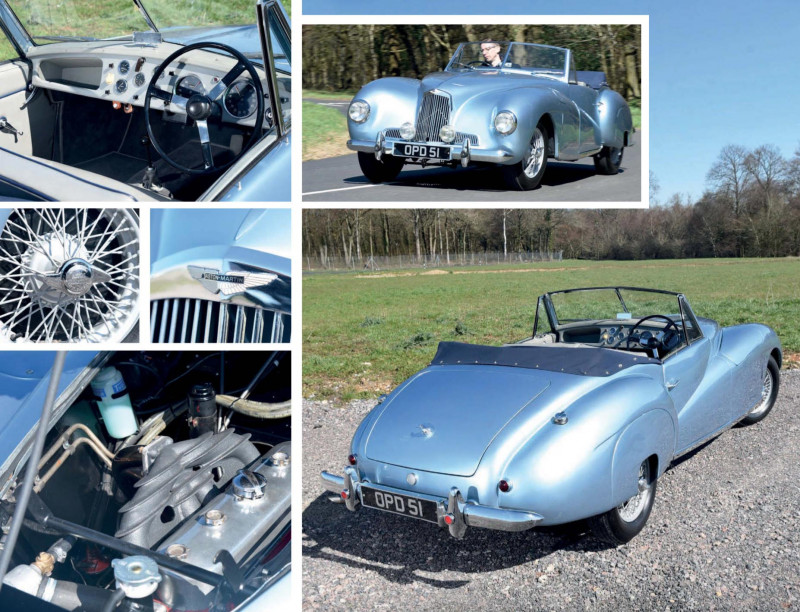
Aston’s winning car was returned to the UK when amongst other appearances it was used for demonstration runs at Shelsley Walsh Hill Climb. The car was later rebuilt with a new body for the 1948 Earls Court Motor Show that kept the original’s large radiator grille but was now flanked on either side by two smaller vents. It was offered for sale at the show as ‘The Spa Replica’ but at £3,109 it wasn’t sold and neither were there any more orders taken, so the sole example was retained by Aston Martin and used by David Brown Jnr until 1950.
The car was involved in a serious accident two years later that resulted in a new chassis. After spending several decades in European museums, the Spa Replica returned to the UK in the early 2000s when it was restored by the then owner. It’s thought the car is now part of a private collection of important Aston Martins based in Switzerland.
Alongside the Spa Replica on Aston Martin’s Earls Court Show stand was the actual production model. Simply called the 2-Litre Sports, with David Brown preferring open cars over closed, it featured a new drophead coupe style of body that was the work of Lagonda designer, Frank Feeley.
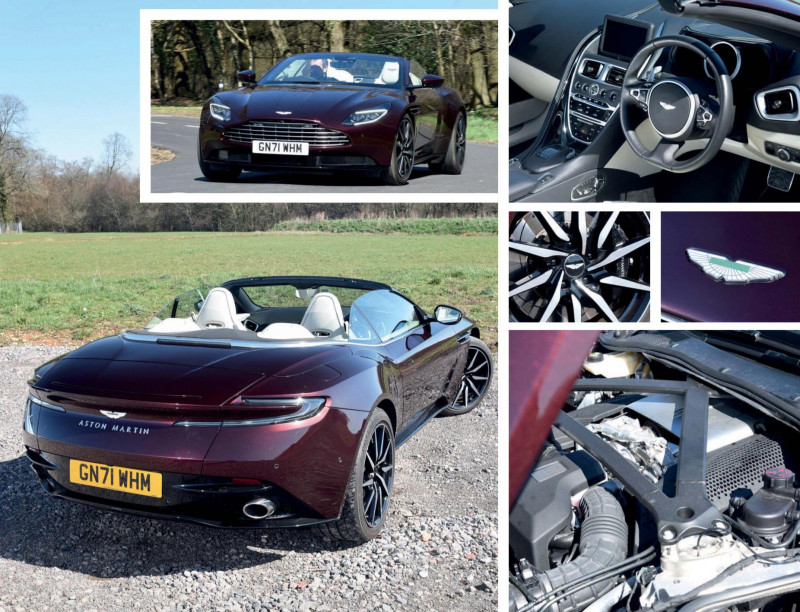
It featured bulbous front wings – their size cleverly allowing for storage of the spare wheel in the right side which was accessed by a removable panel, and the jack and toolkit in the left – which fell in a curve to a point at the base of the two also sounds spectacular: g menacingly at idle, g out its chest with a stentorian roar” doors. The rear wings were egg-shaped complete with spats with cut-outs to make room for the wheel spinners. At the nose was the same three-piece radiator grille design as the Spa Replica although the lower vents were made longer.
“The new Aston Martin with its completely up-to-date lines, carries on the tradition of a series of fine looking open cars,” was Motor magazine’s view in its 6 October 1948 issue.
Hill’s 1,970cc four-cylinder engine was fitted with two SU carburettors and produced 90bhp. It was then joined to a four-speed gearbox sourced from David Brown Engineering located in Huddersfield that had synchromesh on the final three ratios.
With it being a convertible rather than a saloon like the original Atom prototype had been, Hill needed to strengthen the chassis by duplicating the main longitudinal members. The suspension was based on the Atom’s featuring an improved version of its independent trailing-link layout at the front. Coil springs were located at the tip on a cast alloy upright and an anti-roll bar was also fitted. At the back were again coil springs and an anti-roll bar plus a Panhard rod to locate the live axle.
“I felt it essential,” said Hill in the April 1949 issue of Motorsport, “to employ really soft springs to obtain truly comfortable riding and I was confident that I could do this without destroying sportscar controllability.”
Although the leather upholstery and full weather protection made the car relatively luxurious for the time, at £2,331 it was also expensive, especially when the six-cylinder Jaguar XK120 that also debuted at the 1948 Earls Court Motor Show was £1,263.
It was probably due to the high price why the 2-Litre Sports was a slow seller. Despite a privately entered example (registration UMD 123) finishing a fine 11th at the 1949 Le Mans 24 Hours, just 12 examples were produced, including the Spa Replica, before the car was replaced in May 1950 by a larger, grander, and faster DB2. Named in honour of the company’s owner, it resulted in the 2-Litre Sports subsequently but unofficially becoming known as the DB1.
Yet that wasn’t the end of the model. A short time after production had ended, John Cavendish (later Lord Chesham who in 1966 became vice chairman of the Royal Automobile Club) contacted David Brown about buying an Aston Martin convertible. Since the DB2 was a coupe only, Brown replied that the company’s Feltham factory could make him a new 2-Litre Sports, but only if he found two more customers to make the job more cost-effective. Cavendish agreed and in the spring of 1950, the 2-Litre Sports was put back into a very limited production. The three were subsequently registered OPD 51, 52 and 53 with Cavendish’s car being the third.
The example featured here was the first of this series and was originally bought by Dr Campbell Golding of St John’s Wood for his wife, Barbara. The Goldings were friends with the grandfather of current owner, Allan Southward, whose own father, Robin, always loved the car. “He always said to Mrs Golding, ‘When you come to sell it let me know since I think it’s fantastic,’” Allan tells me.
In 1968, when Barbara was ready to sell, she remembered Robin’s enthusiasm and sold it to him for a mere £7 10d. When Robin stopped at the motorway services near his London home after collecting the Aston, a complete stranger offered him £1,000 cash for it, but he still said no, reckoning it was worth more. His father was less than happy with that decision. “He said, ‘Why have you spent money on that rubbish? You should have accepted the offer,’” Allan tells me of his grandfather’s reaction to his son buying the relatively antiquated 18-year-old car.
Robin would drive the DB1 regularly over the next decade and Allan remembers attending several AMOC events with his father and siblings. Although as an engineer, Robin was able to repair the Aston Martin whenever something broke, it was never restored and, according to Allan, by the early Eighties it was starting to fall apart. The final straw came when the front wheels went in opposite directions after Robin braked at the bottom of a hill. It would mark the start of a 40-year restoration.
“My father began to take the car apart piece by piece to fix it,” Allan tells me, “but quickly realised it was held together by a wing and a prayer. A lot of the wood that supports the body had rotted away and the chassis was also rusting so he deconstructed it entirely.”
After the chassis had been shotblasted and repaired, Robin started to rebuild the car at the same time as the owner of the second of the three was restoring his and they started to help each other. But as is often the case, life got in the way and the restoration ground to a halt. “It sat in pieces in boxes,” remembers Allan, “the bodywork was stripped back to the aluminium and was simply resting on the chassis.”
In the late Nineties, Allan convinced his father to allow him to restart the restoration. “I was doing little bits every weekend but it got to the point when I couldn’t get it running and my father, who’d had an operation, couldn’t come in the garage any more to help. So I decided I needed professional help.”
After taking advice from well-known marque specialists, Pugsley & Lewis of Beckenham, Kent, Allan gave the car to Peter Pryce-Tidd of General Automobile Services in south Croydon who in 2014 finally got the car running well enough for it to be put back on the road.
Yet it still wasn’t perfect. The engine had been rebuilt in 1982 but hadn’t been a good job. “It never ran amazingly well,” admits Allan, “and it consumed a lot of oil but as far as my father was concerned, that’s just the way it was.” The four-cylinder unit has only recently been rebuilt by Pryce-Tidd complete with new liners, pistons and conrods while a new radiator and electric fan were also fitted. With the four-speed ‘box reconditioned at the same time, the DB1 is as finished as any old car can be.
Sadly, Robin passed away in 2019. Although for the last few years he’d been too ill to drive, he was still able to sit in the passenger seat of the car he’d loved for seven decades. “It was important I got the car running as well as I could so I could take him to AMOC meetings like he did in the Seventies,” explains Allan. “He was there in 2017 when it was voted runnerup of the People’s Choice Award at the Simply Aston Beaulieu event.”
Looking resplendent in its metallic blue, it doesn’t surprise me when Allan tells me it went one better at the same event a few days before we meet, taking home the trophy.
But if I’m being honest, due to its rather old-fashioned and traditional design, I don’t think it’s as good looking as the svelte XK120. Yet it’s still a very elegant car, the nose dominated by that huge grille treatment that even in this early form clearly reveals its pedigree.
When Allan kindly allows me a drive of his pride and joy, I immediately accept. With only nine of the 15 examples known to have survived (including THX 231 that appeared on the brochure cover, TME 474, the 1948 show car, plus UMD 231, the example that raced at Le Mans in 1949), it makes his DB1 one of the rarest Astons I’ll ever be fortunate enough to experience. It’s certainly easier to climb into than the low-slung Jaguar and offers much more interior room as a result of its design. The interior is typically simple for a car of this age, the dash consisting of several white-on- black dials spread out across the width of the fascia. Yet with the softly sprung bench covered in soft leather plus the full weather protection including winding windows, it makes the car relatively luxurious for a Forties sports model. The throttle is interesting, though, a wooden ring hung off the end of the pedal that rotates under my foot as I press it. After being initially concerned, the unique design actually results in a smooth action.
The four-cylinder engine starts in a heartbeat and although Allan warns me that the rebuilt gearbox is stiff, I soon find first and make a start. In its November 1948 issue, Motorsport said of the engine, “It is an unobtrusive, rugged type of unit.” Seventy years later that’s still the case. The eager and responsive nature of the four-cylinder engine results in a chunky performance that takes me by surprise. With plenty of torque, it’s not always necessary to change down either, the 2.0-litre unit having the ability to accelerate in third or even fourth.
The relatively modern suspension means it rides nicely for a car of this age, easily coping with the imperfections in the road. But at slow speeds, the worm-and- roller steering wanders more than a teenager’s mind during a history lesson. Although it improves slightly at higher speeds, it certainly lacks the accuracy of other performance cars from the period such as the XK120.
Yet this doesn’t detract from the DB1’s appeal or its importance in Aston Martin’s post-war history. The car’s mix of luxury and performance would become the backbone for all future Aston Martin models as the beautiful Devine Red DB11 Volante parked alongside Allan’s car proves.
Due to the iconic status of the famous DB4/5/6 family, there might have been a two-decade gap between the DBS name being dropped in 1972 and the 1993 debut of the DB7, but the DB brand has always been central to the company’s image. The current model is the DB11 that arrived in 2016 as a replacement for the DB9, the DB10 name being used for a bespoke concept model developed specifically for the 2015 James Bond film, Spectre.
Almost seven decades might separate the DB11’s debut from the DB1’s, meaning they’re as different as a Viennese Waltz is from Grime, but the shape of their radiators is an obvious link as it is with all other models. The three-grille layout of the 2-Litre Sports was continued for the DB2 and later amalgamated creating the basic design that’s been used ever since, albeit more stylised.
With the red car powered by the Mercedes-Benz sourced 4.0-litre turbocharged V8 that produces 528bhp (the coupe also has the option of a 5.2 V12 with 630bhp), their performances are as different as their designs. Whereas Allan tells me his DB1 is happiest when trundling at 50mph, the DB11 V8 Volante has a top speed of a face-peeling 192mph.
When I peer inside the DB11, the digital dials, touchscreen and the complicated ventilation controls make the DB1’s interior look like the cockpit of the Wright Flyer by comparison. Yet its lavishness must be how the DB1’s interior was seen when compared to more ordinary cars including the Morris Minor MM and Land Rover that also made their debuts at the 1948 Earls Court Motor Show.
The 2-Litre Sports might not be the first car to be officially called a DB, but there’s no denying it was the first to offer the level of luxury and performance those two letters have come to be closely associated with over the last 75 years.
Thanks to: Allan Southward (DB1) and Kevin Kelly (DB11) plus Winston Rouse from the AMOC (amoc.org)
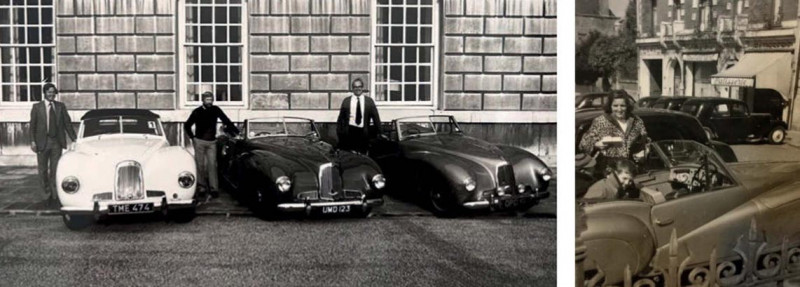
Robin Southward and OPD 51 (far right) with TME 474 that appeared at the 1948 Earls Court Motor Show and UMD 123 that finished 11th at Le Mans in 1949.Barbara Golding with her car during a French holiday in 1954.


